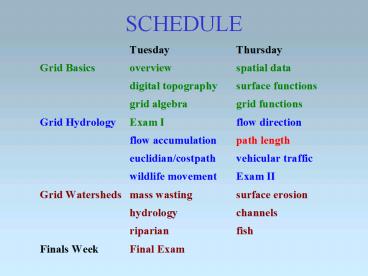SCHEDULE PowerPoint PPT Presentation
Title: SCHEDULE
1
SCHEDULE
2
Discussion Problems
- Revisiting the take-home midterm
- Zipping to move your project
- make directory c/temp/yourname/flowacc
- set working directory
- save project there
- do some work, then save close ArcView
- zip c/temp/yourname/
- move yourname.zip however you like
- extract yourname.zip to c/temp/yourname/
- double click projectname.apr
- This is your project, just as you left it.
3
Discussion Problems
- Revisiting the take-home midterm
- Revisable themes
- look through the themes in the exam
- Which theme can be revised? Which cant?
- What do each group have in common?
- Rewrite them so that they can be revised
- Redo the exam assuming everything mature
- Redo the exam assuming that everything burns
- Map the mature/burned difference in WAR
4
Discussion Problems
Map the stream network from the midterm dem.e00
assuming that all cells with a contributing area
of at least 100 cells is a stream cell. What is
the area of 100 cells? Make stream networks with
different contributing areas. Which one looks
best? Make a grid of all stream headwaters (the
first cell in each stream).
5
Discussion Problems
Runoff from stands in the rain on snow zone is
more sensitive to harvest. Streams that have much
of their contributing area in the rain on snow
zone must be similarly sensitive. If the
rain-on-snow zone is 900-1200m, map the fraction
of the contributing area of each stream reach
that is in the rain on snow zone.
6
Discussion Problems
We might want to put special restrictions on the
rain on snow slopes above the most sensitive
reaches. Identify the stream cells whose
contributing area is mostly in the rain-on-snow
zone Identify the rain-on-snow cells that
contribute to these most sensitive stream
reaches.
7
Discussion Problems
Revisiting the road-side ditch problem By how
much is the contributing area of each stream cell
increased in shifting from natural downhill
routing to roadside ditch interception? Does the
resulting change look different if you use
relative vs. absolute change?
8
OUTLINE
- Flow Length
- Addition
- Multiplication
9
FLOW LENGTHwater flows downhill, butdelivery
decreases with distance
2
3
3
3
3
3
1
2
2
2
2
2
2
2
1
1
0
1
1
0
1
1
2
1
2
2
1
2
3
0
1
2
1
3
0
0
aGrid.FlowLength (weightGrid, upStream)
10
Flow Distance
- Filtering effects increase with distance
Probability(delivery)exp(17.76-D)/46.43
11
FLOW LENGTH Addition
- Distance
- Pdel(17.76-fd.FlowLength(nil,
false)/46.43).exp - Time
- flow_ratek(slope)
- velocityflow_rate/porosity
- time1/velocity
12
FLOW LENGTH Multiplicationsums of logs
x1x2x3x4exp(log(x1x2x3x4)) exp(logx1logx2l
ogx3logx4) flowDir.flowlength(x.log,false).e
xp
13
FLOW LENGTH Multiplication
Fractional delivery fraction xi of input Vi-1 is
delivered to block i1 so if V1V0x1 and V2V1x2
then V2V0x1x2 The delivery fraction can vary We
can multiply these fractions together V0x1x2x3x4
exp(log(V0x1x2x3x4)) exp(logV0logx1logx2log
x3logx4) (V.logfd.flowlength(x.log,false)
).exp
14
FLOW LENGTH Multiplication
- Probability of delivery to the next cell might
decrease with local slope and disturbance
fd.flowlength(f(slope,harvest).ln,false).exp
15
Discussion Problems
Revisiting the road-side ditch question Water
flows faster in ditches than through the soil. If
you count the ditch segments that feed directly
into streams as part of the stream network, then
map the flow length to streams with and without
road ditches. By how much is the average
flowlength above a stream cell reduced by adding
the roads?
16
Practice Problem Identify FlowDirection for each
cell (arrows are okay)
17
Practice Problem Identify FlowAccumulation(nil)
18
Practice Problem Identify streams as cells with
gt10 contributing cells
19
Practice Problem identify flow distance to
streams

